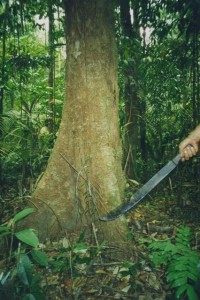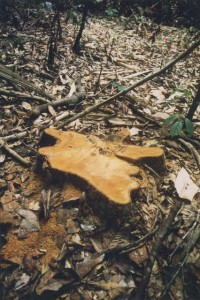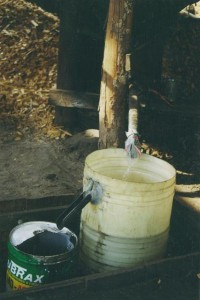The 15th meeting of the Conference of the Parties of CITES, Convention on International Trade in Endangered Species of Wild Fauna and Flora will take place in Doha, Qatar, from the 13th to 25th of March 2010. As with every precedent session since 1989, Robin des Bois will attend.
Currently at CITES there are 175 Parties. Decisions are based on a majority vote of 2/3. Appendix I bans international trade, Appendix II regulates trade and Appendix III is linked to an individual Party decision who asks other CITES Parties for assistance in controlling the trade. Robin des Bois’s summary of the previous CITES session is available on line at the following link (pdf in French).
Brazilian rosewood, rosewood tree (Aniba rosaeodora Ducke):
Chanel uses Brazilian rosewood an essential oil in their perfume n°5, in 1997 a controversy arose around this subject between the perfumery and Robin des Bois. This controversy was closed by a mutual accord on the necessity to protect Brazilian rosewood, notably via controlling international trade, by including the species on Appendix II of CITES and with plantation trials in French Guiana. Currently, essential oils of rosewood are on the market, for the most part they are made out of chemical substances but they could contain traces of the natural essence. The market of “organic farming” certificated oils used in aromatherapy claims Brazilian rosewood to have anti-depressing and aphrodisiac properties. The principal range state Brazil is proposing the inclusion of Brazilian rosewood in Appendix II. All of the French perfumeries are in favour of this proposal. More than 10 years after the start of Robin des Bois’ campaign, the time it takes for diplomacy, this proposal is an important issue for the Robin des Bois association. The battle is far from over as the Parties who profit from the wood industry are generally reluctant about including a tree in appendixes I or II. Concerning this species, clairvoyance by the Brazilians should be acknowledged.
Links available online:
Brazil’s listing proposal, 2010.
Robin des Bois, Chanel meeting November 5th 1997 (French).
The overview distributed to all of the delegates of CITES in 2000 (French).
- © Robin des Bois/C. Nithart et D. Bruno
- © Robin des Bois/C. Nithart et D. Bruno
- © Robin des Bois/C. Nithart et D. Bruno
- © Robin des Bois/C. Nithart et D. Bruno
- © Robin des Bois/C. Nithart et D. Bruno
African Elephant (Loxodonta africana)
The elephant is confronted with war, with human population movements, with tourist parks craze, with deforestation, with the renewed outbreak of ivory trafficking by Chinese citizens on the African continent and finally with greedy nationalism which threaten its nature and its status of migrating species recognised by the Bonn Convention on the Conservation of Migratory Species of Wild Animals. At the last Conference of the Parties (The Hague, June 2007) a one off sale of 108 tons of ivory was authorised, comprising the stocks of Botswana, Namibia, South Africa and Zimbabwe which elephant populations are listed in Appendix II. This one off sale was destined to Japan and China. This sale should be followed by a 9 year moratorium on all official international trade. Yet, today, Tanzania and Zambia are proposing that “their” populations of elephants be downlisted from appendix I to appendix II in order to sell government stocks which adds up to the cumulated weight of 111 tons of Ivory. Tanzania and Zambia are spots of ivory smuggling and sanctuaries for … poachers. These new proposals contribute to the progressive erosion of the banning of international trade of ivory decided by CITES in Lausanne in 1989. To counter balance this, Ghana, Kenya, Liberia, Mali, Congo, Rwanda and Sierra Leone, supported by Benin, Burkina Faso, Central African Republic, Equatorial Guinea, Eritrea, Ethiopia, Guinea Bissau, Mauritania, Niger, Nigeria, Senegal, Togo and the Southern Sudan government propose a suspension of all international commercial transactions for 20 years applicable to all elephant populations be they listed either in appendix I or in appendix II. Robin des Bois is in favour of this proposal: http://www.cites.org/eng/cop/15/prop/E-15-Prop-06.pdf. The price of ivory per kilo on the black market in Asia has risen from $ 750 US in 2006 to $1,860 US in 2009.
Polar Bear (Ursus maritimus)
See the specimen in the photo of a 2.80 m tall stuffed Polar Bear actually on sale
at Stéphane Olivier, rue de l’Université, Paris 6ème for 45,000 euros. Tel : 33 (0)1-42-96-10-00
The Polar Bear is the mascot of all of those announcing global warming. The fact is that the species is already menaced by waste and the dumping of chemical contaminations which degrade the Arctic territory and by the waste of southern countries which are transported by the oceans currents and the atmosphere. Feeding on fish and seals, polar bears are contaminated by PCBs. The international trade of hunting trophies and fur coats is increasing, according to CITES figures at least 2,000 objects per year, not including smuggling, of which the principal source could be Russian Arctic territories. The general decline of Polar Bear populations asks for a legitimate application of the precaution principle taking into account the increasing demand on the world’s markets and the reduction of the ice in the Arctic Ocean, it justifies the proposal presented by the United States to be listed under appendix I. Robin des Bois is in complete agreement whereas the Union European and France, incredibly so, are opposed like Canada. The Polar Bear is listed under appendix II since 1975.
Mariana Mallard (Anas oustaleti)
Listed in Appendix I at the first plenary session of CITES in 1973, it is today subject to a request of removal from appendix I. The reason behind is that the species is extinct. The last trace of an international trade relating to the Mariana Mallard dates back to 2005 and concerned 10 feathers. The Mariana Mallard’s habitat was restricted to Guam, Tinian and the Saipan islands in the western Pacific; it had been sighted and described by explorers in the 19th century. It resembled a Mallard duck. In the Mariana Archipelago it was the victim of universal threats, hunting, it was prey to invasive species and a victim of the drying up of wetlands, over 250 surveys campaigns which were carried out between 1979 and 1993 around seasonal wetlands covering more than 0.5 hectares led biologists to believe that the species was extinct. All attempts at reproduction of the species in captivity have failed.
Deletion proposal:
 Imprimer cet article
Imprimer cet article














